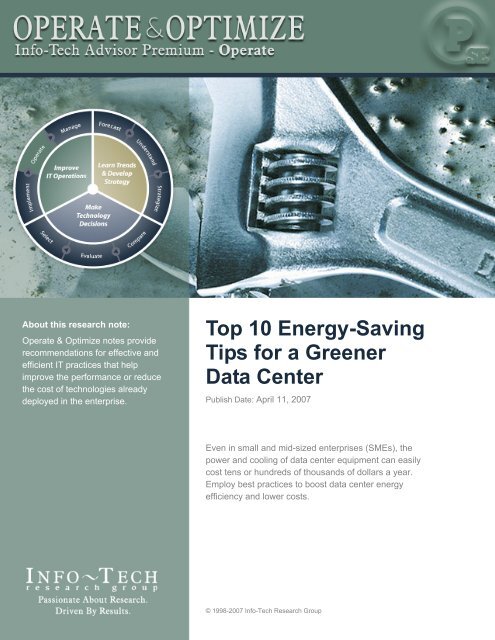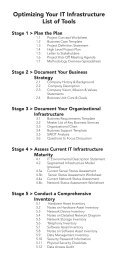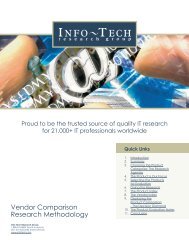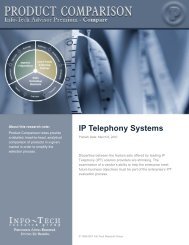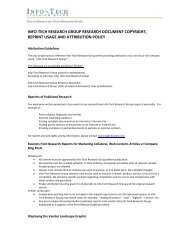Top 10 Energy-Saving Tips for a Greener Data Center - Info-Tech ...
Top 10 Energy-Saving Tips for a Greener Data Center - Info-Tech ...
Top 10 Energy-Saving Tips for a Greener Data Center - Info-Tech ...
Create successful ePaper yourself
Turn your PDF publications into a flip-book with our unique Google optimized e-Paper software.
About this research note:Operate & Optimize notes providerecommendations <strong>for</strong> effective andefficient IT practices that helpimprove the per<strong>for</strong>mance or reducethe cost of technologies alreadydeployed in the enterprise.<strong>Top</strong> <strong>10</strong> <strong>Energy</strong>-<strong>Saving</strong><strong>Tips</strong> <strong>for</strong> a <strong>Greener</strong><strong>Data</strong> <strong>Center</strong>Publish Date: April 11, 2007Even in small and mid-sized enterprises (SMEs), thepower and cooling of data center equipment can easilycost tens or hundreds of thousands of dollars a year.Employ best practices to boost data center energyefficiency and lower costs.© 1998-2007 <strong>Info</strong>-<strong>Tech</strong> Research Group
Executive SummaryRising energy costs coupled with growing computing and storage requirements, new advancements indata center technology, and changing attitudes towards the environment are causing enterprises torethink their data center strategies. Key topics discussed include:» The rising cost of energy and energy inefficiency in data centers.» <strong>Data</strong> center cooling capacity and heat density.» Emerging energy standards.» Best practices <strong>for</strong> achieving a more efficient and cost-effective data center.As energy costs begin to compete with the cost of maintaining the underlying hardware, traditionalthinking around power consumption, heat distribution, and server hardware will change. The newparadigm calls <strong>for</strong> maximizing efficiency and “greener” thinking.This note is optimally focused <strong>for</strong> those enterprises on the “larger” end of the small and mid-sizedenterprise (SME) demographic. These enterprises do not have dedicated data center facilities and aremore likely housing server racks in a shared facility or room within the enterprise’s corporate offices. Fortruly “small” enterprises with only a few servers, there are still some great value nuggets, but realistically,power and cooling issues don’t really become an IT priority until the enterprise has at least a couple ofserver racks. Spending wise, this note targets those enterprises with an IT budget of $1 million or more.Operate & Optimize 2<strong>Top</strong> <strong>10</strong> <strong>Energy</strong>-<strong>Saving</strong> <strong>Tips</strong> <strong>for</strong> a <strong>Greener</strong> <strong>Data</strong> <strong>Center</strong>
Optimization Point<strong>Data</strong> centers operate in an “always on” environment and consume copious amounts of energy. In fact,most estimates suggest power and cooling costs consume approximately 20% of data center budgets.On a macro scale, the US government estimates that US enterprises spend $3.3 billion per year topower their data centers.At large enterprises, data center energy consumption is becoming a serious issue. Executives are takingnote of million dollar electricity bills, demand <strong>for</strong> power and cooling is quickly outstripping existingcapacity, and corporate mandates to become “greener” are bolstering energy efficiency initiatives acrossthe enterprise. Small and mid-sized enterprises (SMEs) are also seeing rising costs that, in proportion tosize and revenue, are very significant. SMEs face similar challenges in terms of growing computing andstorage requirements, rising energy costs, increasing demand <strong>for</strong> cooling, and corporate environmentaldirectives, but are often limited in what they can do to solve the problem.Smaller enterprises don’t have the luxury of designing brand new data centers; in most cases, they arerequired to make do with the facilities they have. Not only that, but in many ways, they lack the energymanagement maturity of larger enterprises (whether due to lack of tools or in-house expertise). Still,there are a variety of energy-saving best practices that are universal and apply to enterprises of all sizes.Key ConsiderationsThe <strong>Data</strong> <strong>Center</strong> <strong>Energy</strong> ImperativeAccording to the Lawrence Berkeley National Laboratory, the average data center has <strong>10</strong> to 30 times theenergy requirement (and cost) of equivalent sized office space. This, coupled with the fact that UScommercial electricity prices have increased over 20% in the past five years, means that data centerenergy consumption is finally attracting the attention of enterprise executives.Un<strong>for</strong>tunately, most data centers are also very inefficient when it comes to energy management. While this iscosting enterprises a significant amount of money, the good news is that IT leaders have an opportunity toimprove the current situation without expanding facilities or investing significantly in new capacity.One of the most popular power/cooling metrics used today (a variation of which is used by The GreenGrid and The Uptime Institute) is overall data center energy efficiency. The metric measures the totalenergy load delivered to the data center versus what is actually consumed by critical IT loads.In a best case scenario, a data center would score in the range of 1.6, meaning that <strong>for</strong> every 1.6 kilowatt(kW) of total electricity going into the data center, 1 kW is consumed by core data center infrastructure,servers, and storage. The remaining 0.6 kW is energy is overhead.Operate & Optimize 3<strong>Top</strong> <strong>10</strong> <strong>Energy</strong>-<strong>Saving</strong> <strong>Tips</strong> <strong>for</strong> a <strong>Greener</strong> <strong>Data</strong> <strong>Center</strong>
However, according to The Uptime Institute, most data centers are operating at a ratio of 2.5 or higher(meaning at least 1.5 kW of energy overhead per kW of IT load).Excessive energy overhead can be generated by a number of factors, including over provisioning, poorairflow and ineffective cooling, inefficient power supplies, switching, unnecessarily redundant systems,inefficient/older equipment, and lighting.The difference between a best case scenario and a worst case scenario can be dramatic in terms ofcost. For example, the annual power and cooling cost of a 20kW rack with an efficiency ratio of 1.6 wouldbe $28,032; however, the same rack with an efficiency ratio of 2.6 would carry a cost of $43,800(assuming $0.<strong>10</strong>/kW-hour). The opportunity <strong>for</strong> savings in this example would be more than $15,000 perrack per year.Cooling Is Half the BattleOptimizing cooling presents the single largest area of opportunity <strong>for</strong> IT to save energy (see Figure 1).Due to the increasing power density and heat generation of newer equipment, cooling and airconditioning energy costs now surpass the cost of powering servers.Figure 1. Typical <strong>Data</strong> <strong>Center</strong> <strong>Energy</strong> ConsumptionSource: American Power Conversion, Cisco, and Emerson Network PowerNetw ork(<strong>10</strong>%)Lighting(3%)Conversion(11%)Cooling(50%)Server/ Storage(26%)Operate & Optimize 4<strong>Top</strong> <strong>10</strong> <strong>Energy</strong>-<strong>Saving</strong> <strong>Tips</strong> <strong>for</strong> a <strong>Greener</strong> <strong>Data</strong> <strong>Center</strong>
Future data centers will require considerably more power and cooling capacity than is available in mostexisting environments. According to both The Uptime Institute and HP Labs, the heat density of datacenters is currently increasing at a rate of about 15% to 20% per year. As devices get smaller, faster,and cheaper, enterprises are packing more machines into rooms that were not designed toaccommodate the increased cooling burden. So, even though individual devices may produce less heat,the aggregate number is driving up cooling requirements and energy consumption.As an example, data centers three or more years old housed racks that consumed 5 kW to <strong>10</strong> kW ofelectricity or less. However, newer racks are easily in the range of 20 kW or more. According to IBM,some high-density server racks (such as blades) draw as much as 30 kW of power. This translates intoan annual per-rack power and cooling cost of between $35,000 and $60,000, depending on theefficiency of the data center.Since both heat density and computing requirements are growing, but server rooms are most likely notexpanding, heat density will increase not only at the rack level, but also over the entire room. Manyexisting server rooms were designed based on an assumption of an average heat load (across the room)in the range of 40 to 70 watts per square foot (W/ft 2 ). These data center environments are not equippedto handle heat loads being generated by many of the newer high density racks that can boost powerdensity to 300 W/ft 2 or more.Rising heat density is inevitable and not necessarily something that is within the enterprise’s control.However, knowing heat densities and identifying heat concentrations <strong>for</strong> various areas is necessary inorder to deploy the appropriate cooling strategy. Higher heat densities also require more coolingredundancy because denser systems increase in temperature much faster, thus reducing the windowduring which cooling systems can be offline.Standards are ComingWith standards and ratings, IT decision makers will be able to make better purchasing decisions andbetter evaluate products based on an energy-inclusive TCO analysis. While vendors and industryregulators are still a bit behind on the power and cooling issue, they are catching up. Several parties inthe US, including the Standard Per<strong>for</strong>mance Evaluation Corporation (SPEC), the EnvironmentalProtection Agency (EPA), and the US Legislature have recently begun to evaluate server energyefficiency metrics in an attempt to create standards.The US Senate and House of Representatives recently passed bills (House Bill 5646 and Senate Bill3684 respectively) that promote data center energy efficiency. The SPEC (which includesrepresentatives from AMD, Dell, EMC, Hewlett-Packard, Intel, IBM, Oracle, Sun, and many others) isahead of the game and has already begun publishing some preliminary benchmarks.Operate & Optimize 5<strong>Top</strong> <strong>10</strong> <strong>Energy</strong>-<strong>Saving</strong> <strong>Tips</strong> <strong>for</strong> a <strong>Greener</strong> <strong>Data</strong> <strong>Center</strong>
Another important working group seeking to lower the overall consumption of power in data centers isThe Green Grid, which lists AMD, APC, Dell, Hewlett-Packard, IBM, Rackable Systems, SprayCool, Sun,and VMware among its founding members.Improvement & OptimizationThe following recommendations are geared towards those enterprises on the “larger” end of the SMEdemographic. These enterprises do not have dedicated data center facilities and are more likely housingserver racks in a shared facility or room within the enterprise’s corporate offices. Truly “small” enterpriseswith only a few servers will also benefit from some of the best practices discussed, but realistically,power and cooling issues don’t really become an IT priority until the enterprise has at least a couple ofserver racks and an IT budget of $1 million or more.<strong>Data</strong> center design and management is evolving to maximize energy efficiency and lower coolingrequirements. Implement the following ten best practices to ‘do more with less’ when it comes to powerand cooling:1. Right-size IT equipment. The number one way to reduce asset acquisition as well as ongoingenergy costs is rightsizing IT equipment to match near-term requirements. This is a step that canbe taken by enterprises of all sizes – even those with only a few servers. Case studies show thataverage server utilization rates range from <strong>10</strong>% to 20% of capacity. Equipment – includingservers, storage, power supplies, UPS systems, air conditioners, fans, and air exchange systems– operating with significant overcapacity is a waste.In addition to lowering IT investment in fixed assets, The Green Grid estimates that rightsizing ITequipment can reduce energy consumption by as much as 50%. This is due to the fact that fixedlosses in power and cooling are present regardless of how much IT load is actually being used.Where possible, smaller enterprises should invest in modular, scalable equipment and addcapacity only as growth in IT loads demands it. Also, prioritize availability requirements <strong>for</strong>applications and services to balance uptime against costs. The ongoing energy costs ofmaintaining fully redundant systems can easily match or surpass the cost of simply duplicatingthe hardware. Even if IT has no intention of implementing chargebacks to business units,providing a cost allocation <strong>for</strong> energy consumption in proposals to business leaders will helpconvey the message that high availability comes with an associated “energy burden.” Significantenergy savings can be achieved by ruthlessly prioritizing and only providing redundancy where itis really needed.Operate & Optimize 6<strong>Top</strong> <strong>10</strong> <strong>Energy</strong>-<strong>Saving</strong> <strong>Tips</strong> <strong>for</strong> a <strong>Greener</strong> <strong>Data</strong> <strong>Center</strong>
2. Foster communication between IT and facilities. For the most part, energy costs are invisibleto the IT department because the electricity bill is managed by the facilities department,independently of data center personnel. This problem is exacerbated in small IT shops becausein many cases the data center exists in a shared facility where power and cooling are metered atthe building level and accounted <strong>for</strong> as corporate “general and administrative” expenses. Thisallows IT to remove itself from the problem and not worry too much about how much energy iswasted. The majority of IT departments don’t know what the annual energy spend is <strong>for</strong> the datacenter and IT and facilities departments don’t generally coordinate ef<strong>for</strong>ts unless there’s arelocation involved.However, <strong>for</strong> energy savings to be realized, there needs to be better visibility into what the otherside is doing. IT needs to understand how purchasing decisions affect facilities and what thebaseline is in order to track improvement. Similarly, facilities must know ahead of time what’scoming down the pipeline in terms of power, space, and cooling requirements. Virtually all energyefficiency-related metric gathering initiatives should be joint IT-facilities projects.3. Track and manage the energy consumption of IT equipment. Tracking energy usage in thedata center provides a baseline <strong>for</strong> calculating the ROI of new energy saving initiatives and helpsidentify areas of opportunity. Moreover, energy management products can reduce energy useduring regular operation and can keep critical applications running during brown-outs.Best of breed products will track and manage power intake, monitor inlet/outlet air temperatures,and allow administrators to throttle server CPU per<strong>for</strong>mance to match requirements and savepower. As an example, HP recently announced Insight Power Manager (originally introduced as ablade product). The software allows administrators to track and adjust how much power serversare using. IBM’s PowerExecutive offers similar functionality.In order to monitor non-IT equipment such as air conditioning and UPS devices, involve the facilitiesdepartment. For small facilities with shared air conditioning and electricity metering, these metricsmay be difficult to obtain. In this case, consider investing in “smart metering” capabilities thatseparately measure usage in different areas and provide the desired level of granularity.4. Engage in longer-term capacity planning <strong>for</strong> power and cooling infrastructure. The growthin electrical and cooling requirements may cause a shortage of power and cooling capacity in theenterprise’s data center. A critical extension to right-sizing equipment is using energyconsumption data to develop <strong>for</strong>ecasts, assess future capacity requirements, and avoidunpleasant surprises. Since expanding or building a new data center may not be an option, takesteps now to reduce energy consumption and improve current capacity utilization.Operate & Optimize 7<strong>Top</strong> <strong>10</strong> <strong>Energy</strong>-<strong>Saving</strong> <strong>Tips</strong> <strong>for</strong> a <strong>Greener</strong> <strong>Data</strong> <strong>Center</strong>
Tailor the data center cooling solution based on the current and projected heat density andtype of infrastructure used. For example, a rack housing 21 2U dual core servers might onlydraw six or seven kW of power, whereas as a high per<strong>for</strong>mance, high density blade rack candraw 20 kW of power. Each scenario requires a different cooling strategy. To expand coolingcapacity incrementally, consider precision cooling solutions such as spot cooling that targetproblem areas. If floor space is an issue, consider units that are either ceiling-mounted orintegrated into the rack.5. Explore server consolidation and virtualization to improve energy efficiency. As a furthercontinuation of rightsizing, use server/storage consolidation and virtualization as a way toeliminate redundant/inefficient equipment, improve capacity utilization, and reduce electricityconsumption.» Save on hardware too. <strong>Info</strong>-<strong>Tech</strong> research suggests that server virtualization can reduceone-time and ongoing hardware acquisition costs by 40% to 75%, as well as reduceongoing maintenance costs (incorporating power and cooling) by between 25% and 50%.» Evaluate rebates. To take savings a step further, utility company Pacific Gas & Electric(PG&E) (Cali<strong>for</strong>nia only) offers rebates to IT shops involved in server consolidation andvirtualization.» Watch out <strong>for</strong> the cooling trap. Consolidation and virtualization can contribute toincreased heat density (more computing power in a smaller space) and raise concernsabout cooling.6. Upgrade legacy equipment. Older servers, switches, routers, and storage solutions tend to beless efficient and generate more heat than newer models. In addition, older hardware lacks thesensors and instrumentation to support energy management solutions. Holding on to legacysystems beyond their useful life can escalate energy costs both as a result of redundant or seldomusedapplications that run unnecessarily and due to the poor efficiency of the old hardware (i.e.inefficient power supplies and fans, excessive heat output, and uneconomical design).Keeping up with new advances in energy efficiency will always be a challenge. Developing migrationplans <strong>for</strong> all IT equipment from the get-go will allow <strong>for</strong> more predictable budgeting and ensure that ITis always running the most efficient configurations possible. Consolidating using blade servers canalso help reduce physical space requirements while using less energy <strong>for</strong> the same processing poweras rack mount servers. As an added bonus, many high-per<strong>for</strong>mance blade systems also includepower management tools to help with tracking and monitoring energy efficiency.Operate & Optimize 8<strong>Top</strong> <strong>10</strong> <strong>Energy</strong>-<strong>Saving</strong> <strong>Tips</strong> <strong>for</strong> a <strong>Greener</strong> <strong>Data</strong> <strong>Center</strong>
7. Revisit TCO calculations. It is no longer acceptable to use equipment TCO models that omitconsiderations such as annual power and cooling costs. The real TCO of infrastructurecomponents include energy costs, which can easily rival the cost of maintaining the underlyinghardware. This becomes especially important when making the case <strong>for</strong> initiatives such as thereplacement of legacy systems, adoption of blade servers vs. traditional rack mounted servers,multi-core processors, and server/storage virtualization and consolidation.8. Deliver more targeted and adaptive cooling. Room-level air conditioners are imprecise andinefficient. For racks with an average heat output of 15 kW to 20 kW (or more), consider coolingsolutions at the rack level that transfer heat close to the source as opposed to allowing it todiffuse throughout the surrounding area. Modern rack-level cooling solutions are also adaptive inthat they can be automatically adjusted to meet changing heat outputs based on server load. Thisnot only saves energy, it also allows space-constrained enterprises to squeeze more data centerequipment into smaller spaces.One study from the Rocky Mountain Institute suggests that liquid cooling can reduce coolingenergy costs by as much as 30% to 50% when compared against standard air-based room airconditioners. IBM, Sun, HP, and Egenera all recently announced liquid cooling technologies thatare expected to be more efficient than traditional <strong>for</strong>ced air methods. Refrigerant cooling takeswater-based to the next level by making it safer in the event of a leak or ruptured pipe (refrigerantescapes as gas and will there<strong>for</strong>e not damage equipment if leaked). Several vendors offer air,water, and refrigerant cooling systems that are integrated directly into the rack or server.However, these are not cheap. As an example, ISR’s SprayCool M-Series runs about $25,500 <strong>for</strong>a 1-rack setup supporting up to 36 1U servers. Egenera’s CoolFrame <strong>for</strong> its Bladeframe adds$300 to $400 per blade to the price tag. In addition, these systems may require changes to theexisting air conditioning systems and ducting. For more guidance on selecting a blade system,refer to the ITA Premium SE research note, “Blade Servers <strong>for</strong> Small Enterprises.”» SprayCool’s solution supports Dell, HP, and IBM hardware. In addition, US-based Avista,a Pacific Northwest utility, offers rebates (up to $3,600 per rack) to enterprises that installSprayCool-enabled servers.» 42U boasts up to 30 kW of cooling capacity per rack.» Liebert has several solutions including enclosures with integrated air or water-based cooling.» HP’s Modular Cooling System can also deliver up to 30 kW of cooling capacity usingchilled water.Operate & Optimize 9<strong>Top</strong> <strong>10</strong> <strong>Energy</strong>-<strong>Saving</strong> <strong>Tips</strong> <strong>for</strong> a <strong>Greener</strong> <strong>Data</strong> <strong>Center</strong>
9. Improve airflow management. Air distribution is key when it comes to efficient cooling. Properdata center air management minimizes the mixing of hot air emitted from equipment with the coolair supplied to it. Efficient air distribution can help increase the density capacity of the data center(W/ft 2 ), reduce heat-related malfunctions, and lower operating costs. The Uptime Institute foundthat on average 60% of the cold air supplied to the data center was wasted due to poor airflow.Similarly, PG&E suggests that poor airflow management can decrease the cooling capacity of aComputer Room Air Conditioning unit (CRAC) by 50% or more.A recognized approach to efficient air handling and air-flow management is implementing a coolaisle/hot aisle layout. This model is optimized when airflows are separated by enclosing aisles,thus allowing <strong>for</strong> more effective cooling. Rows of racks are arranged such that there arealternating cold (air intake) and hot (heat exhaust) aisles between them. However, in retrofitsituations, where comprehensive redesign is not an option, consider simple low-costimprovements to optimize existing air supply/return configurations.» Look <strong>for</strong> short-circuiting airflows. The term “short circuiting” refers to the mixing ofhot exhaust air and cool intake air. Make sure cable cutouts and holes in the perimeter walls(and the raised floors where applicable) are properly sealed to prevent this. Also, use blankingpanels to fill unused rack space and prevent air mixing in hot aisle/cool aisle scenarios.» Use flexible barriers where fixed ones are not available. Specialized/custom rack productstake cool aisle/hot aisle setups to the next level by supplying cool air directly to the rack airintake and drawing hot air out without letting it travel through the room at all. Depending onthe current layout and ductwork, this can be a costly venture. Barriers made of clear plastic orother materials can be used to cost-effectively achieve similar results.» Reposition poorly placed overhead air supplies. Instead of looking to cool the entireserver room (mixing hot and cool air), reposition overhead diffusers so that they expel cool airdirectly in front of racks where it can be drawn into the equipment. Up-flow computer room airconditioning units (CRACs) should be located near the end of a hot aisle and fitted with ductsthat bring cool air to points above cool aisles as far away as possible from the CRAC. Downflowunits should be oriented to blow air down a cool aisle. Return vents should be locatedover the hot aisles using a dropped-ceiling return air plenum (or hanging ductwork return).» Reposition poorly placed thermostats. Place the thermostat in front of the equipmentwhere air temperature is more indicative of equipment temperature. Alternatively, <strong>for</strong>servers that support Simple Network Management Protocol (SNMP) heat sensors, actualequipment temperature can be pulled directly from the management software.» Control fan speeds based on need. Fans set to operate at maximum capacityregardless of data center temperature waste energy.Operate & Optimize <strong>10</strong><strong>Top</strong> <strong>10</strong> <strong>Energy</strong>-<strong>Saving</strong> <strong>Tips</strong> <strong>for</strong> a <strong>Greener</strong> <strong>Data</strong> <strong>Center</strong>
Adjust the fan speed of CRAC air handlers in order to reduce the air volume suppliedduring times when equipment is running cooler (i.e. at part-load). According to PG&E,small reductions in air volume supplied result in a non-linear reduction in fan power; so a20% drop in airflow volume results in a 45% to 50% reduction in fan energy consumption.» Investigate “free” cooling via economizers. Airside economizers bring in cool outsideair when weather conditions permit, thus reducing the burden on air conditioning units.While these systems are expensive to install (economizers can cost tens of thousands ofdollars <strong>for</strong> the unit, and thousands more to install), they can significantly reduce long-termcooling costs <strong>for</strong> SMEs that have larger server rooms with several racks. Depending onoutside conditions, an economizer can reduce data center cooling costs by more than60%, according to a recent report from PG&E.<strong>10</strong>. Shop green. Look <strong>for</strong> products with eco labels and those that include specific efficiency ratings.When writing RFPs <strong>for</strong> new equipment, include specific terms <strong>for</strong> heat output, cooling capacity,and energy consumption.» Buy servers with energy-efficient power supplies. Look to the EPA’s <strong>Energy</strong> Starprogram to start offering ratings <strong>for</strong> server efficiency now that U.S. House and Senate billsencouraging EPA involvement have been passed. In the meantime, look <strong>for</strong> productscontaining 80 PLUS certified power supplies.» Seek rebates from utilities. In an ef<strong>for</strong>t to reduce new investments in electricitygeneration, a few US utility companies are creating incentives to try and counter theenergy consumption of power-hungry data centers. Expect others to follow suit.» Look <strong>for</strong> new innovative offerings. With the recent push towards energy efficiency,many vendors are coming out with innovative new products.Bottom Line- Cisco started 2007 on a green foot. In addition to getting its own house in order (thecompany’s internal green initiatives will save $20 million over a three-year period) andhosting Webinars on green data center design, Cisco also offers a range of productsthat claim to reduce power consumption and improve operating efficiency.- Sun has developed more efficient chips and servers and claims that its UltraSPARCprocessor is so efficient that it could reduce worldwide server demand by 50%.- HP and IBM offer software to adjust the power consumption of servers to match the load.Even in SMEs, the power and cooling of data center equipment can easily cost tens or hundreds ofthousands of dollars a year. Employ best practices to boost data center energy efficiency and lower costs.Operate & Optimize 11<strong>Top</strong> <strong>10</strong> <strong>Energy</strong>-<strong>Saving</strong> <strong>Tips</strong> <strong>for</strong> a <strong>Greener</strong> <strong>Data</strong> <strong>Center</strong>


